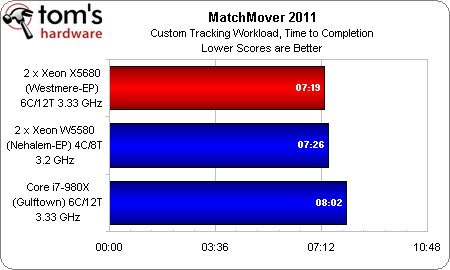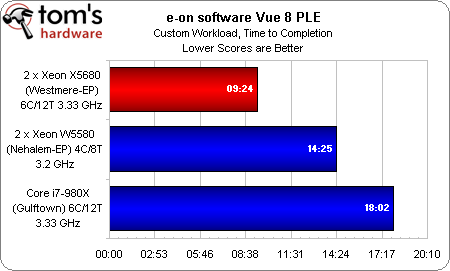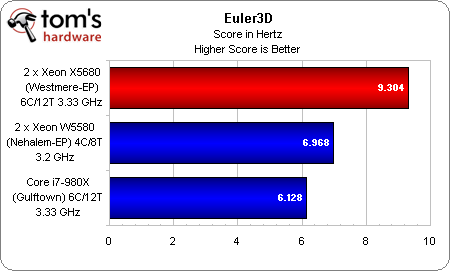Intel Xeon 5600-Series: Can Your PC Use 24 Processors?
The professional space is peppered with products derived from the desktop. Today we're looking at Intel's Xeon X5680 CPUs, which look a lot like Core i7-980X, only they're optimized for dual-socket platforms. We're also introducing new Adobe CS5 tests.
Benchmark Results: MatchMover 2011, Vue 8 PLE, And Euler3D
Per Wikipedia: “In cinematography, match moving is a visual-effects technique that allows the insertion of computer graphics into live-action footage with correct position, scale, orientation, and motion relative to the photographed objects in the shot. The term is used loosely to refer to several different ways of extracting motion information from a motion picture, particularly camera movement. Match moving is related to rotoscoping and photogrammetry. It is sometimes referred to as motion tracking.”
The first step in match moving is identifying and tracking features—and that’s what our MatchMover 2011 benchmark does, using custom footage taken by Jon Carroll on Hollywood’s Walk of Fame.
The threading here seems light, if existent at all. Naturally, the Xeon X5680s have a small clock rate advantage over the W5580s, but it’s a little more difficult to explain both dual-socket configurations’ lead on the Core i7-980X. At the very least, we can say it’s probably not worth upgrading to a dual-socket arrangement just for this app.
On the other hand, Vue does show a definite proclivity for more potent processors. For the unfamiliar, Vue is used to create, animate, and render 3D environments, so it’s not surprising that this professional app appears well-optimized for multi-core, multi-threaded workstations.
Our test scene finishes in less than 10 minutes using a pair of Xeon X5680s. The same task takes more than 18 minutes on a single Core i7-980X. The scaling here is superb.
Based on the STARS Euler3D computational fluid dynamics production code, Euler3D’s workload is described as follows:
“The benchmark testcase is the AGARD 445.6 aeroelastic test wing. The wing uses a NACA 65A004 airfoil section and has a panel aspect ratio of 1.65, a taper ratio of 0.66, and a 45 degree quarter-chord sweep angle. This AGARD wing was tested at the NASA Langley Research Center in the 16-foot Transonic Dynamics Tunnel and is a standard aeroelastic test case used for validation of unsteady, compressible CFD codes…The benchmark CFD grid contains 1.23 million tetrahedral elements and 223 thousand nodes. The benchmark executable advances the Mach 0.50 AGARD flow solution. Our benchmark score is reported as a CFD cycle frequency in Hertz.”
Get Tom's Hardware's best news and in-depth reviews, straight to your inbox.
This one is deliberately optimized for threading (another version of the test is available to test in a single-threaded environment). Naturally, then, the dual-socket Xeon X5680 platform scores a first-place win. The Xeon W5580 takes second, though it’s held back somewhat by its slower clock rate.
Current page: Benchmark Results: MatchMover 2011, Vue 8 PLE, And Euler3D
Prev Page Benchmark Results: Media Encoding And Cinebench Next Page Benchmark Results: LightWave 3D 9.6-
enzo matrix one-shotOr 24 Logical CPUs, not really Processors.Misleading title. I was excited because I assumed intel had finally come out with 12-core server CPUs.Reply -
Tamz_msc I was expecting an even better performance from these CPUs.The performance is still limited by the software you use.Reply -
shin0bi272 Enzo MatrixMisleading title. I was excited because I assumed intel had finally come out with 12-core server CPUs.they could have gone 4x 6 core cpus without HT too.Reply -
cangelini Enzo MatrixMisleading title. I was excited because I assumed intel had finally come out with 12-core server CPUs.Reply
The Xeon 5600-series tops out with 6 cores and 12 threads, yielding 24 logical processors between two sockets. =) -
wh3resmycar ReplySo many cpu's in task manager...do all but 1 go unused running a single threaded app? shame intel had to go this route with more cores instead of making single core with hyper-threading work faster. you should really only need 2 logical cpu's and hyper threading accomplishes it with 1.
i have a feeling you dont understand what the word "workstation" means. -
Hyper threading was kind of cool back in the P4 days, but now I don't see the point. Virtually nothing that >people actually use< has any benefit to see from it.. It just makes for cool screenshots imo..Reply
I guess what this review says is that, if you want performance for stuff you do at home you should pretty much just get a Nehalem i7 6c with some fast ram. The xeons seems to be behind on everything multimedia, much as expected. -
Otus cangeliniThe Xeon 5600-series tops out with 6 cores and 12 threads, yielding 24 logical processors between two sockets. =)You should have written "logical processors" or "logical cores" and no one would have argued.Reply
mheagerNot true. Hyper threading makes it so if one app gets stuck in an endless loop it doesn't suck up all the cpu and freeze the computer.The OS can do that even on a single core with no HT. Not to mention the case with many physical cores which non-HT CPUs have nowadays. -
kokin mheagerNot true. Hyper threading makes it so if one app gets stuck in an endless loop it doesn't suck up all the cpu and freeze the computer.But why should it get stuck in an endless loop with all that computing power?Reply



